Chiral Recognition of Carnitine Enantiomers Using Graphene Oxide-Modified Cadmium Telluride Quantum Dots †
Abstract
1. Introduction
2. Experiment
2.1. Materials
2.2. Apparatus
2.3. Synthesis of GO-CdTe QDs
2.4. GO-CdTe QDs for Chiral Recognition of CA
3. Results and Discussion
3.1. Characterization of GO-CdTe QDs
3.2. Chiral Recognition of CA Enantiomers by GO-CdTe QDs
3.3. Change in Fluorescent Signal
3.4. Selectivity of Proposed Method for CA Enantiomers
4. Real-Sample Assay
5. Conclusions
Author Contributions
Funding
Institutional Review Board Statement
Informed Consent Statement
Data Availability Statement
Conflicts of Interest
References
- Guoping, Z. Application of Chirality and Chiral Substances. J. Hubei Second Norm. Univ. 2013, 30, 28–31. [Google Scholar] [CrossRef]
- Wang, D.J.; Zhu, Z.X.; Wei, Y.; Deng, Z.; Miao, H. Effects of L-CA on microinflammatory status in patients with end-stage renal disease. Chin. Gerontol. 2009, 29, 467–469. [Google Scholar]
- Vogt, C.; Kiessig, S. Separation of D/L-CA enantiomers by capillary electrophoresis. J. Chromatogr. A 1996, 745, 53–60. [Google Scholar] [CrossRef]
- Zhao, Y.; Wu, H.; Yang, J. Prospect of chiral recognition methods in environmental analysis. J. Chongqing Three Gorges Univ. 2015, 31, 99–103. [Google Scholar]
- Rao, C.E.N.E.R.; Sood, A.E.K.; Subrahmanyam, K.E.S.; Govindaraj, A. Graphene: The new two-dimensional nanomaterial. Angew. Chem. Int. Ed. 2009, 48, 7752–7777. [Google Scholar] [CrossRef] [PubMed]
- Geim, A.K. Graphene: Status and prospects. Science 2009, 324, 1530–1534. [Google Scholar] [CrossRef] [PubMed]
- Wang, L.; Song, F.; Hou, J.; Li, J.; Cheng, Y.; Zhu, C. In situ Cu(II)-containing chiral polymer complex sensor for enantioselective recognition of phenylglycinol. Polymer 2012, 53, 6033–6038. [Google Scholar] [CrossRef]
- Ding, L.; Liu, P.; Li, S. Research progress on toxicity and safety of nanomaterials. Mater. Rev. 2010, 24, 29–32. [Google Scholar]
- Bremer, J. CA-metabolism and functions. Physiol. Rev. 1983, 63, 1420. [Google Scholar] [CrossRef] [PubMed]
- Haeckel, R.; Kaiser, E.; Oellerich, M.; Siliprandi, N. CA: Metabolism, function and clinical application. J. Clin. Chem. Clin. Biochem. Z. Klin. Chem. Klin. Biochem. 1990, 28, 291–295. [Google Scholar]
- Guo, Y.; Zeng, X.; Yuan, H.; Huang, Y.; Zhao, Y.; Wu, H.; Yang, J. Chiral recognition of phenylglycinol enantiomers based on N-acetyl-l-cysteine capped CdTe quantum dots in the presence of Ag. Spectrochim. Acta Part A Mol. Biomol. Spectrosc. 2017, 183, 23–29. [Google Scholar] [CrossRef] [PubMed]
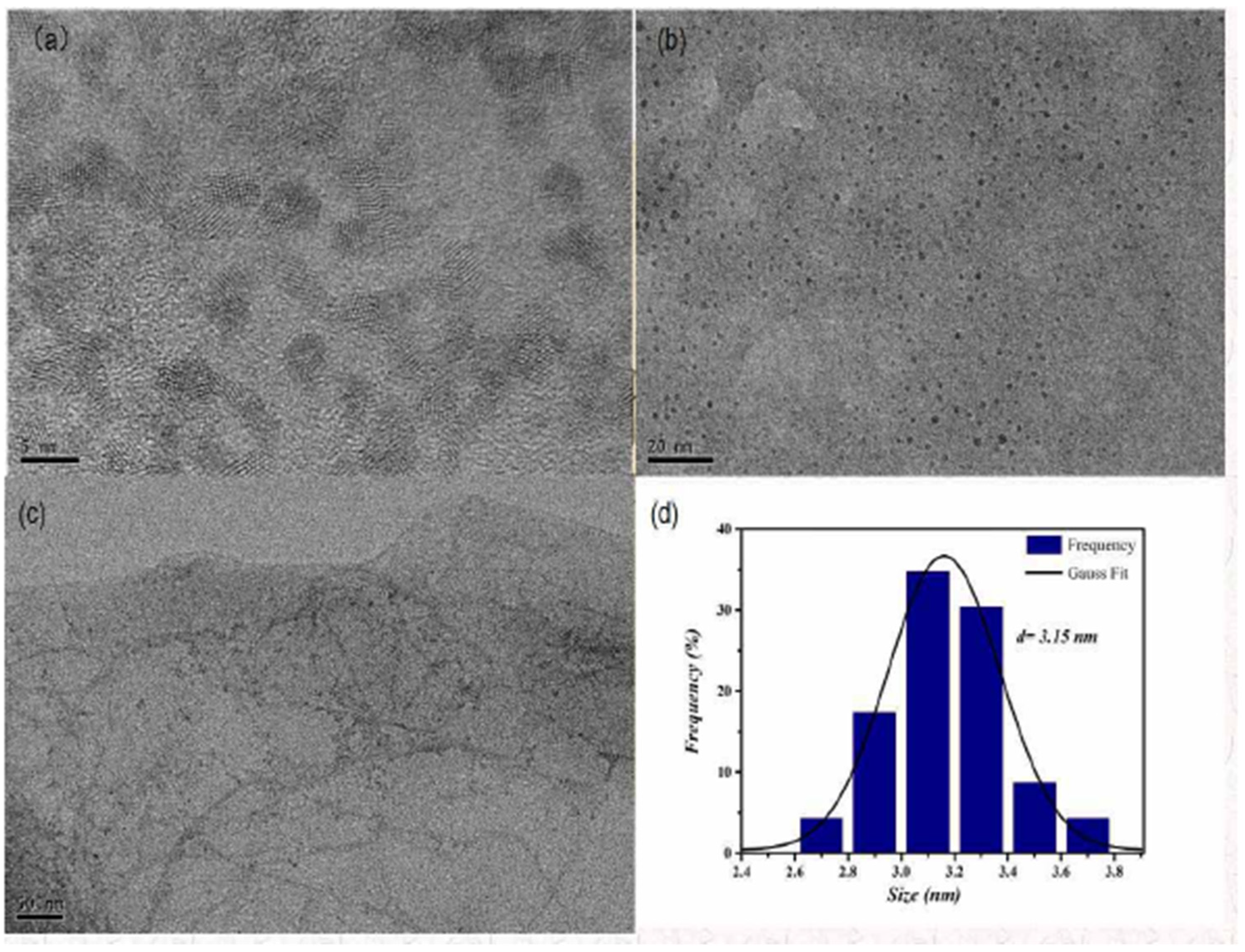
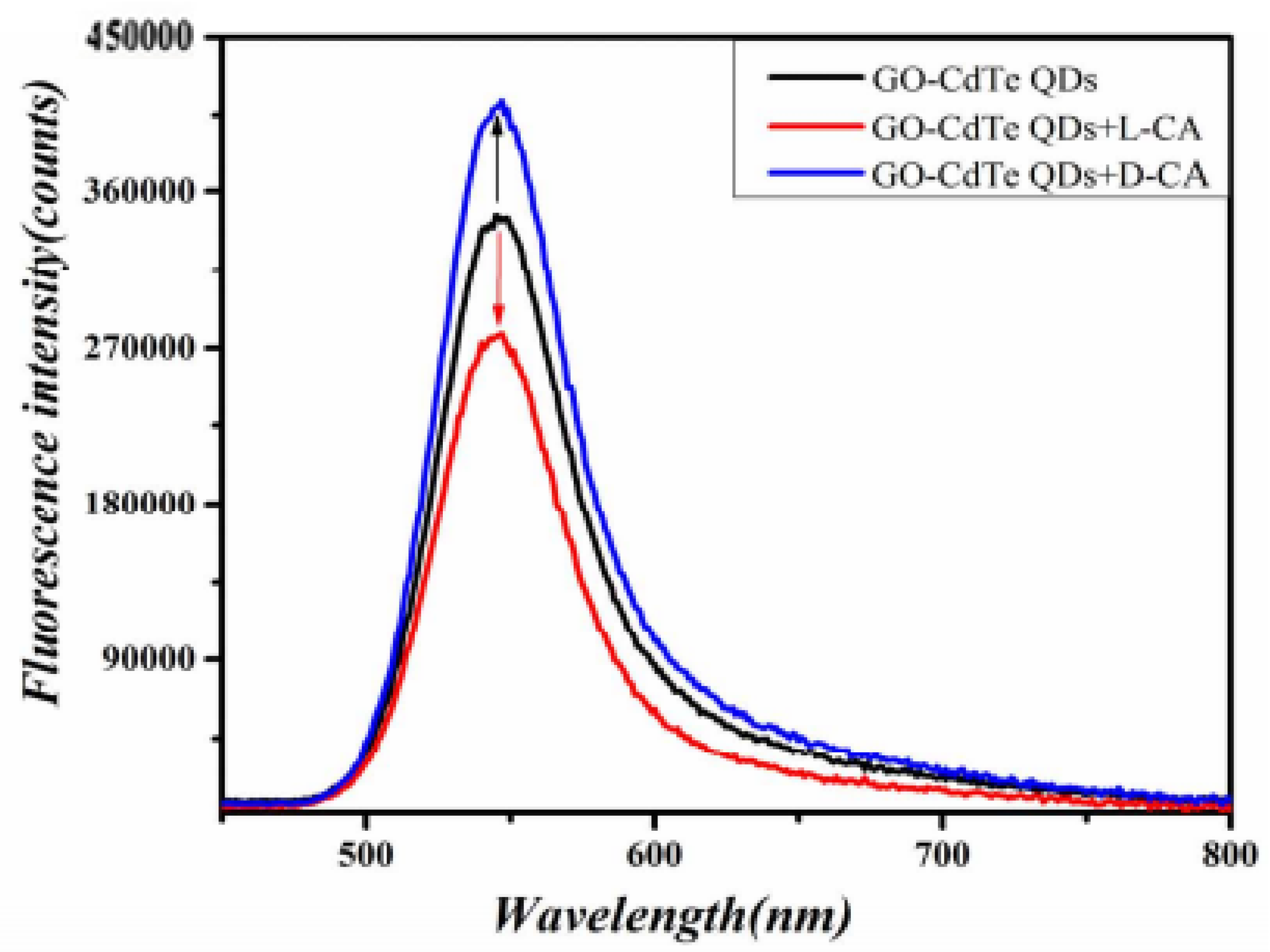
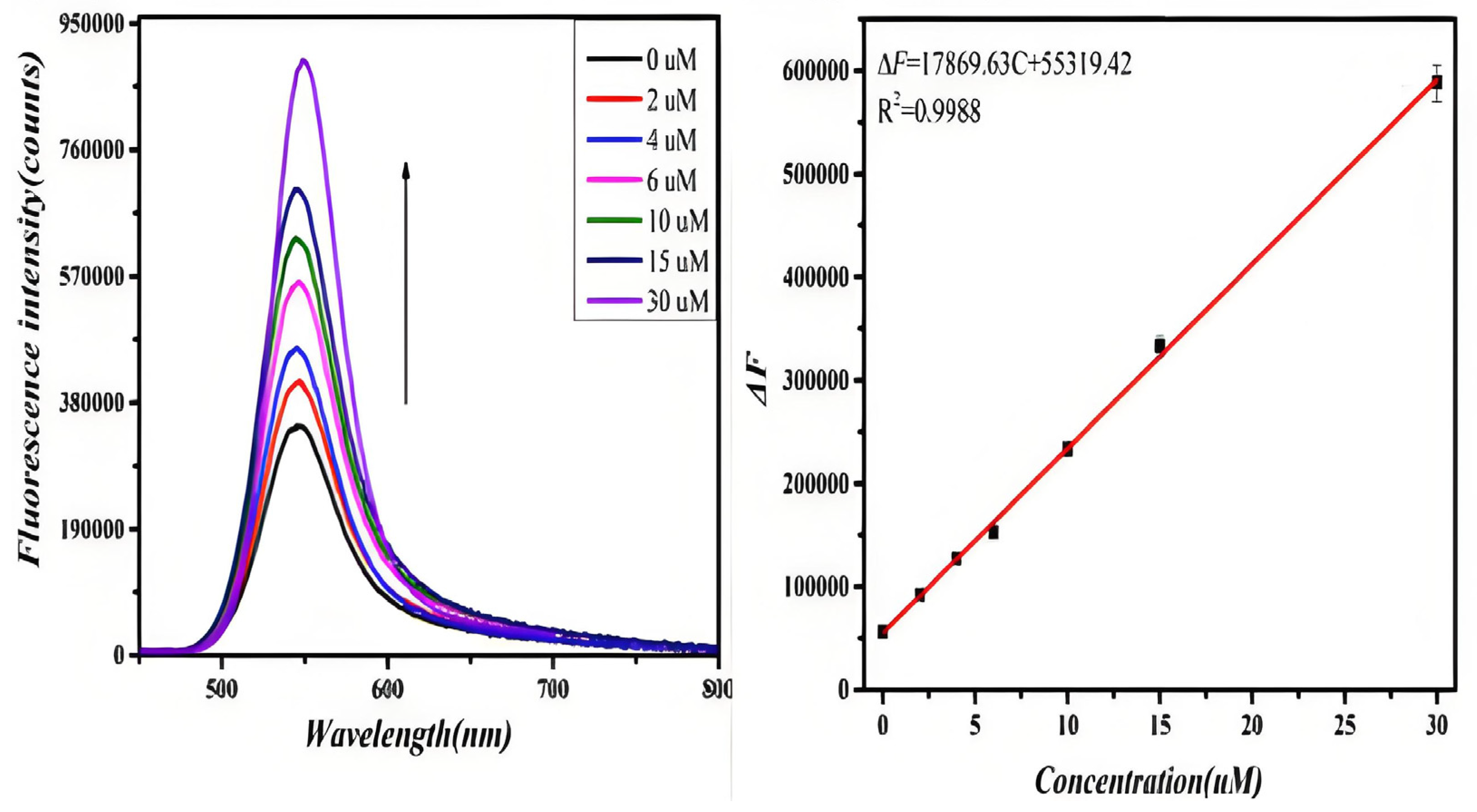
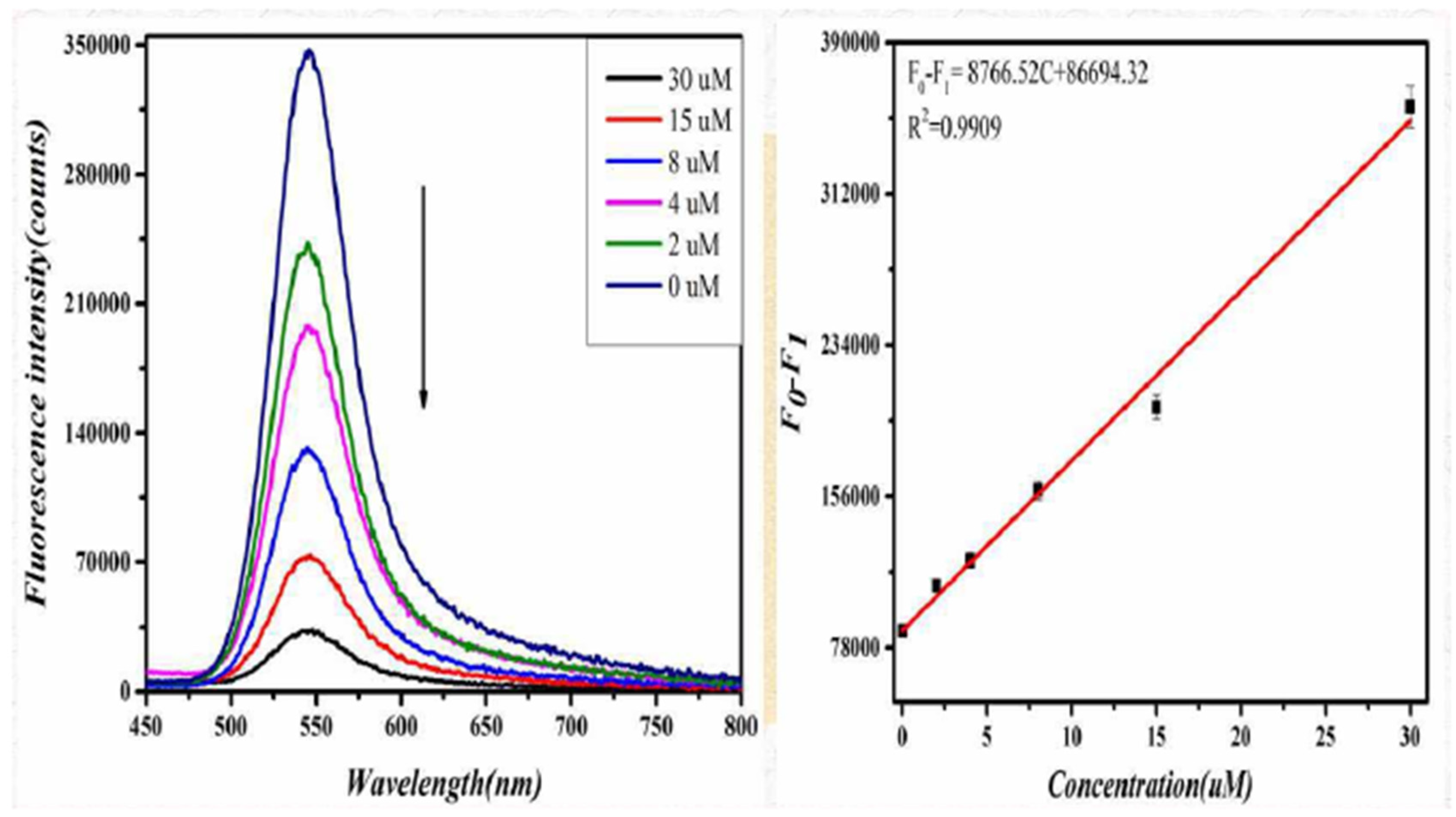

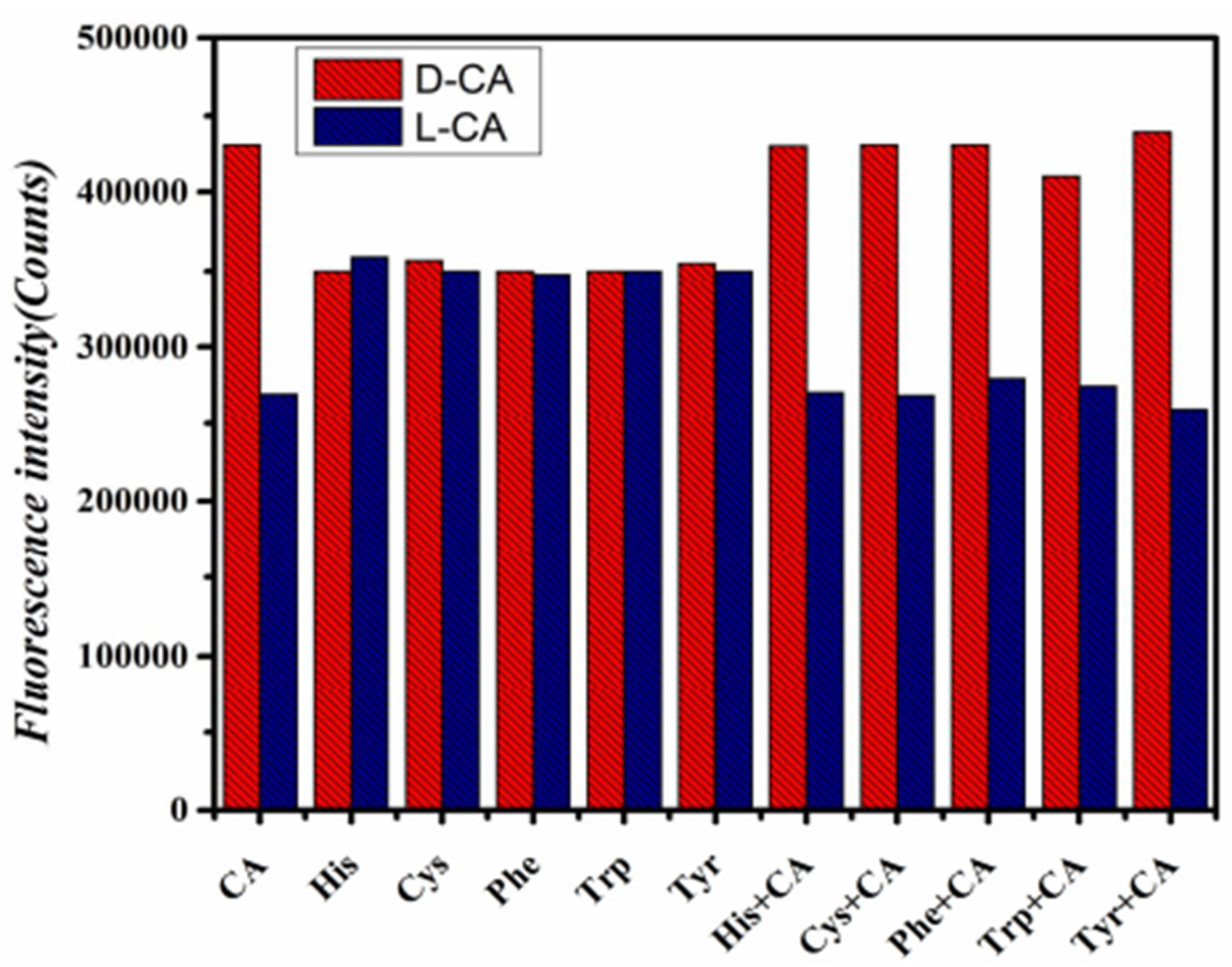
| Number | Value (g/tablet) | Added L-CA (g) | Measured L-CA (g) | Recovery Rate (n = 5, %) | RSD (%) (n = 5) |
|---|---|---|---|---|---|
| 1 | 0.11 | 0.1 | 0.22 | 104.1 | 2.1 |
| 2 | 0.09 | 0.2 | 0.28 | 96.5 | 2.5 |
| 3 | 0.13 | 0.3 | 0.44 | 102.3 | 2.2 |
Disclaimer/Publisher’s Note: The statements, opinions and data contained in all publications are solely those of the individual author(s) and contributor(s) and not of MDPI and/or the editor(s). MDPI and/or the editor(s) disclaim responsibility for any injury to people or property resulting from any ideas, methods, instructions or products referred to in the content. |
© 2025 by the authors. Licensee MDPI, Basel, Switzerland. This article is an open access article distributed under the terms and conditions of the Creative Commons Attribution (CC BY) license (https://creativecommons.org/licenses/by/4.0/).
Share and Cite
Yuan, H.; Ma, Y.; Zhang, Y.; Yang, J.; Mei, Z.; Pi, C.; Peng, Y. Chiral Recognition of Carnitine Enantiomers Using Graphene Oxide-Modified Cadmium Telluride Quantum Dots. Eng. Proc. 2025, 98, 34. https://doi.org/10.3390/engproc2025098034
Yuan H, Ma Y, Zhang Y, Yang J, Mei Z, Pi C, Peng Y. Chiral Recognition of Carnitine Enantiomers Using Graphene Oxide-Modified Cadmium Telluride Quantum Dots. Engineering Proceedings. 2025; 98(1):34. https://doi.org/10.3390/engproc2025098034
Chicago/Turabian StyleYuan, Haiyan, Yu Ma, Yuhui Zhang, Jidong Yang, Zhiyuan Mei, Chengcheng Pi, and Yuan Peng. 2025. "Chiral Recognition of Carnitine Enantiomers Using Graphene Oxide-Modified Cadmium Telluride Quantum Dots" Engineering Proceedings 98, no. 1: 34. https://doi.org/10.3390/engproc2025098034
APA StyleYuan, H., Ma, Y., Zhang, Y., Yang, J., Mei, Z., Pi, C., & Peng, Y. (2025). Chiral Recognition of Carnitine Enantiomers Using Graphene Oxide-Modified Cadmium Telluride Quantum Dots. Engineering Proceedings, 98(1), 34. https://doi.org/10.3390/engproc2025098034





